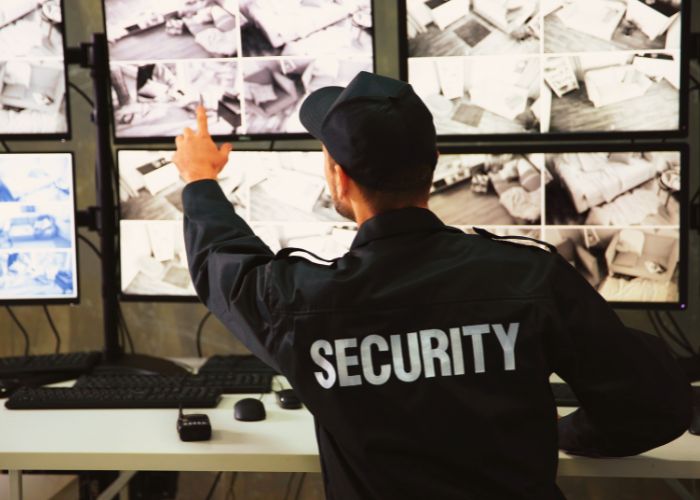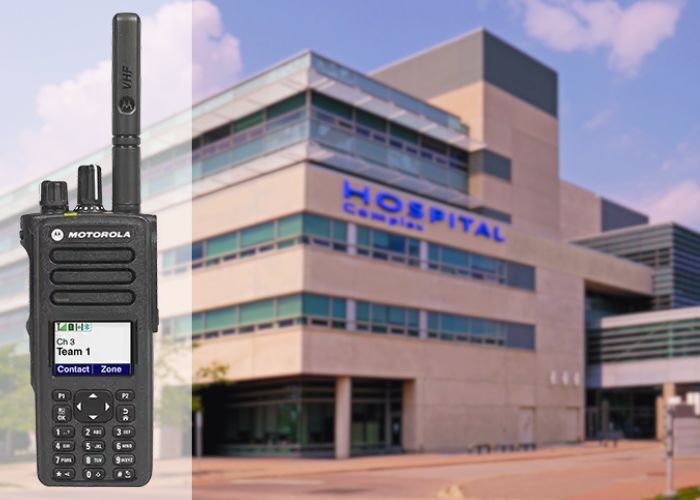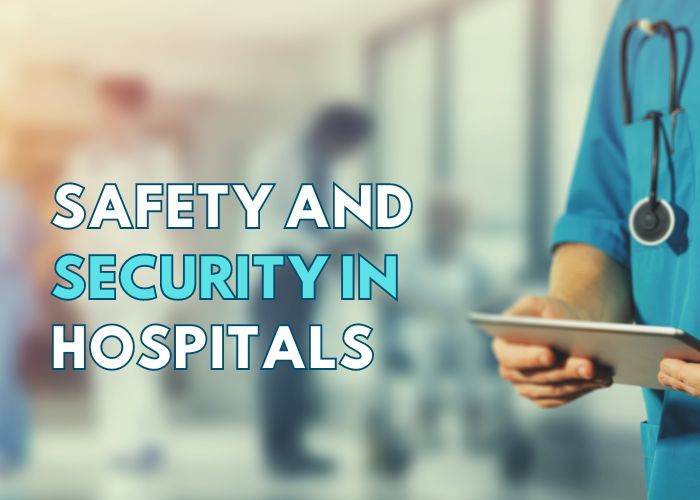In hospitals and healthcare environments, safety and security are vital for the well-being of patients and healthcare workers. Unfortunately, violence and crime pose ongoing challenges in these settings. Investing in healthcare by adopting innovative technology solutions for occupational health and safety allows businesses to work smarter, not harder when creating a safe workspace. This proactive approach can lead to increased employee morale, productivity and most importantly it adds safety to people and key assets.
When faced with emergency situations, security and applicable hospital staff need a way to communicate quickly without interference. Two-way radios help address these needs and safety concerns by providing a quick communication lifeline. Unlike cell phones, which may experience delays or network issues, two-way radios offer instant and reliable communication. This ensures hospital staff can promptly respond to incidents, creating a safer environment for everyone in the healthcare facility.
Current Landscape of Safety Issues in Hospitals
Workplace violence in healthcare settings poses a significant challenge, often rooted in the conditions and behaviors of patients. This issue is particularly pronounced as patient populations in hospitals are more likely to be intoxicated, exhibit psychosis, delirium, or have dementia, all known risk factors for violence.
Disturbingly, data from the Bureau of Labor Statistics in 2018 reveals that healthcare workers accounted for 73% of all nonfatal workplace injuries related to violence, surpassing the risks faced by police officers. The COVID-19 pandemic further exacerbated this problem, highlighting the vulnerabilities healthcare professionals face.
Plos One’s study highlights the concerning prevalence of workplace violence in the healthcare sector. Shockingly, a cumulative total of 10,821 healthcare workers have reported incidents experiencing violence. The breakdown of violence types reveals that 71.9% were verbal, while 28.1% were physical. Among the affected roles, doctors accounted for 62.3%, nurses for 20%, and medical secretaries for 7.4%. These findings show the pressing need for enhanced safety measures in healthcare settings.
Insights from the IAHSS Foundation 2022 Crime Survey
In 2021, hospitals faced an alarming increase in violent crime rates, as revealed by the IAHSS Foundation’s 2022 Crime Survey. Notably, disorderly conduct dropped from 56.8 incidents per 100 beds in 2021 to 52.2 in 2022, indicating a positive shift. The survey also found slight decreases in theft (from 5.7 to 5.6) and burglary (from 0.7 to 0.5), highlighting a reduction in these criminal activities. The report emphasized that violent crime, encompassing murder, rape, robbery, and aggravated assault, decreased from 2.5 to 1.9. Among these incidents, aggravated assault accounted for 78%, emphasizing its prevalence in this category.
Contrastingly, the survey indicated increased vandalism (from 2.6 to 2.8) and motor vehicle theft (from 0.4 to 0.6). Simple assault also saw a significant rise, escalating from 17.7 incidents per 100 beds to 22 incidents. The data revealed a concerning trend, with the simple assault rate more than doubling from 2019 to the present. The IAHSS Foundation’s 2023 Healthcare Crime Survey provides crucial insights into the evolving landscape of hospital crimes, offering valuable information for crafting effective safety measures and policies.
Challenges Faced by Hospital Workers
Hospital workers confront multifaceted challenges, with safety concerns at the forefront. Workplace violence, ranging from verbal abuse to physical assaults, poses a significant threat to healthcare professionals, affecting doctors, nurses, and medical secretaries. The data from the Bureau of Labor Statistics underscores the severity, revealing that in 2018, healthcare workers accounted for a staggering 73% of all nonfatal workplace injuries due to violence. Moreover, the IAHSS Foundation’s 2022 Crime Survey highlights the increasing rates of hospital crimes, with a concerning rise in simple assaults and other criminal activities.
Beyond intentional harm, hospitals also grapple with the impact of natural disasters on safety and response. Disruptions caused by events like earthquakes or hurricanes pose a unique set of challenges, requiring comprehensive emergency preparedness. Quick and effective communication becomes uber-important during these emergencies, ensuring a coordinated response.
Two-way radios are essential in facilitating this communication, offering a lifeline for hospital staff to address evolving situations swiftly. In the face of these challenges, prioritizing safety measures and embracing advanced communication tools becomes imperative to fortify the resilience of hospital workers and enhance overall safety within healthcare facilities.

The Role of Two-Way Radios in Hospital Safety
Rugged two-way radios can be critical tools in the pursuit of safe and secure surroundings. Their high-performance communication capabilities are indispensable when addressing security matters, creating an environment where everyone within and around medical facilities can feel secure.
One of the primary functions of two-way radios is immediate communication during medical emergencies. In critical situations, the ability to convey information rapidly can make a crucial difference in patient outcomes. These radios also enhance the response to acts of violence by enabling quick communication among hospital staff, facilitating a coordinated and efficient response to security incidents.
Recent technological advances have transformed two-way radios beyond simple voice communication. They now support advanced features such as text messaging, GPS, location mapping, man-down notifications, work order ticketing, and integration with various alarm systems. This interoperability provides a comprehensive protection and communication approach across the hospital campus.
Adopting advanced digital two-way radio technology equips healthcare facilities to improve response during emergencies, mitigate incidents, and enhance the overall productivity of security staff and other hospital workers.
Hypothetical Scenarios to Consider
Imagine a scenario where a hospital staff member discovers a suspicious individual exhibiting aggressive behavior. In such a situation, the immediate communication capability of two-way radios becomes a crucial asset. Staff can quickly relay information to security personnel, enabling a fast response to prevent escalation.
In another hypothetical scenario, a medical emergency arises in a patient’s room, requiring urgent assistance. Two-way radios empower healthcare professionals to communicate instantly, ensuring that the right personnel are mobilized promptly, and necessary resources are brought to the scene without delay.
Consider a situation where a natural disaster strikes, causing chaos and potential evacuations within the hospital. Two-way radios, with their advanced features like GPS and location mapping, facilitate efficient coordination among different departments, ensuring a well-organized response to manage the crisis and safeguard patients and staff.
Benefits of Two-Way Radios in Hospital Security
As integral tools in the healthcare industry and hospital security, two-way radios provide a myriad of benefits that contribute to creating a safe and efficient environment. The seamless communication offered by these devices is invaluable, especially in critical situations where immediate response is essential. Here are key benefits:
- Ease of Use: Two-way radios offer a user-friendly interface, ensuring quick and straightforward communication, vital in high-stress situations.
- Private and Secure Communication: While not HIPAA compliant, users can be trained to avoid sharing personally identifiable information, maintaining a level of privacy and security in communication.
- Durability and Long Battery Life: Built for the demanding hospital environment, these radios are durable and equipped with long-lasting batteries, ensuring continuous operation during prolonged emergencies.
- Integration with Other Systems: Advanced two-way radios seamlessly integrate with various hospital systems, including alarm systems and smartphones, providing a comprehensive security approach.
- Instantaneous Group Communication: With the ability to facilitate group communication, two-way radios enhance coordination among security personnel, allowing for swift responses to unfolding situations.
- Scalability: Whether a small clinic or a large hospital campus, two-way radio systems are scalable, adapting to the specific needs and size of the healthcare facility.
These benefits collectively empower hospital security teams to respond effectively to emergencies, maintain order, and ensure the safety of patients, staff, and visitors.

Motorola Digital Radios Enhance Hospital Safety
Elevating hospital safety, Motorola’s digital radios offer a cutting-edge solution for seamless communication in critical situations. When precision and coordination are paramount, upgrading from analog to a digital two-way radio network becomes imperative.
Motorola’s MOTOTRBO solutions delivers instant and reliable communication, enriched with additional intelligence, ensuring that specific teams or individuals can connect swiftly, especially in times of crisis where push-to-talk communication proves invaluable.
MOTOTRBO presents a comprehensive solution, offering a diverse lineup tailored to the unique needs of healthcare facilities. Rugged radios built to military specifications, coupled with infrastructure, systems, accessories, applications, and services, create an end-to-end package. This ensures that hospital staff can communicate effectively at all times, addressing emergencies promptly and establishing direct connections between management and frontline responders.
The advantages of MOTOTRBO extend beyond cellular limitations, providing enhanced features like Bluetooth, Wi-Fi, GPS tracking, text messaging, and compliance with IP standards and military specifications, making it an indispensable tool designed to perform ensuring hospital safety.
EMCI Wireless is Your Partner for MOTOTRBO Solutions
EMCI Wireless is your dedicated partner, committed to fortifying healthcare facilities with cutting-edge MOTOTRBO solutions. Safety and security within hospitals are non-negotiables, and two-way aid in addressing these concerns. We understand the unique challenges faced by healthcare professionals and the critical need for fast and reliable communication during emergencies.
Our MOTOTRBO solutions, with their advanced features and seamless integration, empower hospital staff to respond effectively, ensuring the safety of patients, visitors, and healthcare workers.
As your trusted partner in enhancing hospital safety, we encourage you to take the next step in upgrading your communication systems. Contact us today and discover how our MOTOTRBO solutions can revolutionize safety and security in your healthcare facility.






